Here’s my story from the ARRL January VHF Contest.
Setup Challenges
My original plan was to activate the IC-9700 on 144/432 and the IC-9100 on 50/222 with a six meter amp and 222 transverter. Then an IC-7300 arrived just a couple days before the contest. That’s sweet. But at that point the challenge became setting up all the software and adding external switching between the amp and transverter with a brand new rig.That was accomplished and actually fairly easily with the Icom USB connection.
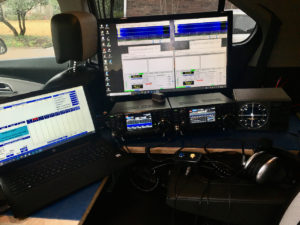 But next I found that the device I built to allow one pair of headphones/mic/PTT to drive both rigs was, in addition to it’s original purpose, a super-duper RF receptor-injector. Press PTT and the audio level immediately jumped to full output. Coping with that required separate microphones and the use of the rig speakers instead of headphones. That, of course, made for interesting exchanges during the rove when picking up the wrong microphone.
But next I found that the device I built to allow one pair of headphones/mic/PTT to drive both rigs was, in addition to it’s original purpose, a super-duper RF receptor-injector. Press PTT and the audio level immediately jumped to full output. Coping with that required separate microphones and the use of the rig speakers instead of headphones. That, of course, made for interesting exchanges during the rove when picking up the wrong microphone.
For this rove I added a large monitor and relied on a Windows laptop for logging and WSJT-X rather than my MacBook Air. I managed to fit everything in and overall it worked well. I also added a back shelf to hold the amp for 6 and the transverter for 222. The new DC power system worked, except for a few alarms for low voltage.
The rooftop rotator mount went together fine. It’s now the third contest for the mount, this time with the addition of the 222 Yagi along with an upgraded 2″ aluminum mast. It all went together nicely, but does take quite a bit of time and effort to assemble everything. Even so, that’s far better than the deploying the push-up mast at each grid stop.
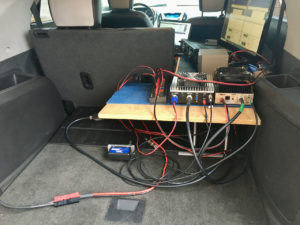 The challenges, however, continued as I arrived at my first grid about an hour before the contest opened. I discovered that my laptop could connect to my cellphone hotspot but didn’t have Internet access. I tried lots of stuff, but no luck.
The challenges, however, continued as I arrived at my first grid about an hour before the contest opened. I discovered that my laptop could connect to my cellphone hotspot but didn’t have Internet access. I tried lots of stuff, but no luck.
What it meant in practice was that if I wanted to use VHF-Chat-Slack or PingJockey I needed to use my phone. That didn’t work too well and in fact pretty much shut down communication during the contest save for a few text messages.
Next I found that when transmitting with WSJT-X on the IC-9700 the RF, I presume, shut down the USB connection for both rigs. I ended up using the IC-7300 on 6 FT8 and MSK144 but not the other rig on the other bands. I’ll be doing more testing this week to resolve this issue. Works fine in the shack — but of course I’m not sitting in a metal box directly underneath the antennas.
Moxon Tree-Hugger
 The top of my mast comes in at exactly 12 feet, which is where the stressed Moxon is mounted. I’d snagged a tree once during my original testing of the roof top mount over a year ago as I drove into my neighborhood.
The top of my mast comes in at exactly 12 feet, which is where the stressed Moxon is mounted. I’d snagged a tree once during my original testing of the roof top mount over a year ago as I drove into my neighborhood.
Essentially what happens is the wire snags a branch or two followed by wrenching the entire antenna around and sometimes pulling out one of the aluminum rods on each side that fits into the front of the antenna.
 Usually, I’m savvy enough to avoid those roads. But this time I had plotted out a possible new location just over the grid line. Driving to that spot on Saturday I heard the grind, observed the shaking tree branch and falling leaves in the rearview mirror, and knew that I had testing the 12 foot limits and failed. So I didn’t go any further down that road, which looked even worse ahead. Then at my next stop I was standing on top of the car with wrenches in hand reassembling the antenna.
Usually, I’m savvy enough to avoid those roads. But this time I had plotted out a possible new location just over the grid line. Driving to that spot on Saturday I heard the grind, observed the shaking tree branch and falling leaves in the rearview mirror, and knew that I had testing the 12 foot limits and failed. So I didn’t go any further down that road, which looked even worse ahead. Then at my next stop I was standing on top of the car with wrenches in hand reassembling the antenna.
Unfortunately I had the same experience on a narrow dirt road with overhanging trees in Oklahoma while activating EM14, 24, 23, 13. Fortunately, I reassembled it at the next stop and kept going. It’s a great antenna. I’ll just order some new aluminum rods to replace the bent ones and continue to watch those low hanging branches.
OK Rovers
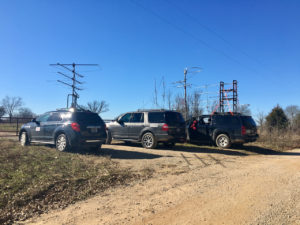 That last tree-hugging incident happened early Sunday morning when I met up with Randy N0LD/R and Ross K5SRT/R at the intersection of four grids in Oklahoma. They added lots of QSOs to my logbook on all my bands and a few multipliers as well. Thank you OK Rovers.
That last tree-hugging incident happened early Sunday morning when I met up with Randy N0LD/R and Ross K5SRT/R at the intersection of four grids in Oklahoma. They added lots of QSOs to my logbook on all my bands and a few multipliers as well. Thank you OK Rovers.
That was such a wonderful experience but I’ll note that I also greatly value my solo extreme radio sport roving. I like it mostly for the chance it gives me to work everyone I can hear and spend extra time on a few long range contacts with those who are seeking a particular grid for their VUCC or FFMA tally.
Moments of Note
The big moments I’ve already described with setup challenges, RF into everything, tree-hugging, and lack of ready Internet connection. But I also had some amusing encounters along the way.
At my stop for EM02, which was in a driveway along the highway, I noticed a guy in a tractor with front-end loader coming out of the next driveway and heading toward me. I got out of the car and asked if I needed to move. He replied that he just wanted to see if I needed any help. I didn’t ask him what he intended to do with the front-end loader.
After I explained what I was up to, he noted that way back when he had an amateur radio license and owned a Drake transceiver. I encouraged him to get back on the air, but he said he was too busy.
 Another moment was at my stop for EM14. This was on a very narrow dirt road at a spot that Randy N0LD had mapped out for the OK Rover activation. The only place to park was in the fence cutout for access to a barn and feedlot directly across from the farmer’s home.
Another moment was at my stop for EM14. This was on a very narrow dirt road at a spot that Randy N0LD had mapped out for the OK Rover activation. The only place to park was in the fence cutout for access to a barn and feedlot directly across from the farmer’s home.
As I was setting up, I saw him walking up to the car. I got out to explain and found that he was concerned about my upsetting his cows. He stated that they were fed this time of day along with the fact that he had to bottle feed an orphan calf. I offered to move but he said I was OK. You can see my photo of the barn nearby. You can also see the rising sun from this spot in the photo at the top of this blog post.
Overall Results
VHF Contest Log reports that I had a score of 6,975 with 119 contacts and 45 multipliers. Along the way I activated 11 grids — pretty much keeping to my original route with a few stops chopped where I’d either already activated the grid or planned to the next day. My miles driven were 370 on Saturday and 330 on Sunday.
There were 77 contacts on phone, most with the OK Rovers, and 42 digital contacts. For bands it was 58 QSOs and 15 grids on 6, 25/7 on 2, 16/5 on 222, and 20/7 on 432.
Kudos to Dan W5AFY in EM04 and Marshall’s team at K5QE in EM31. They provided contacts at nearly every stop. I am amazed at the 6 m FT8 contacts with W5AFY. One text and a couple of minutes later the QSO was in the log, no matter what grid I was in. He must have an amazing station. Marshall was also very helpful in working FT8 on 6 and SSB on my other bands. Just call and they do all they can to point their antennas and make the QSO.
I will post all QSOs to Logbook of the World under K5ND/R later this week.
Postmortem
I was surprised with the lack of SSB at the beginning of the contest. Usually, I point my antennas at Austin and San Antonio and work quite a few SSB contacts on all my bands. But I only heard K5QE when the contest started. I’ve also specifically set up my route to take advantage of this level of activity — starting at my most southern stop.
It also meant that 6 meter FT8 was the go to mode. I should have been able to try out 2 meters as well, but my RFI problems shut that down.
I’ve currently left the rover all set up. I’m planning to take some time to fully assess and test solutions for the problems I’ve encountered as noted above. I’ve got a long list of what worked and what didn’t. Once some solutions are in place, I further plan to develop documentation so that I have a much better plan of action for the next setup.
Thanks everyone for the QSOs. Sorry that I wasn’t able to get everyone into the log that wanted some of the rarer grids that I activated. Hopefully the next contest will remedy that situation.
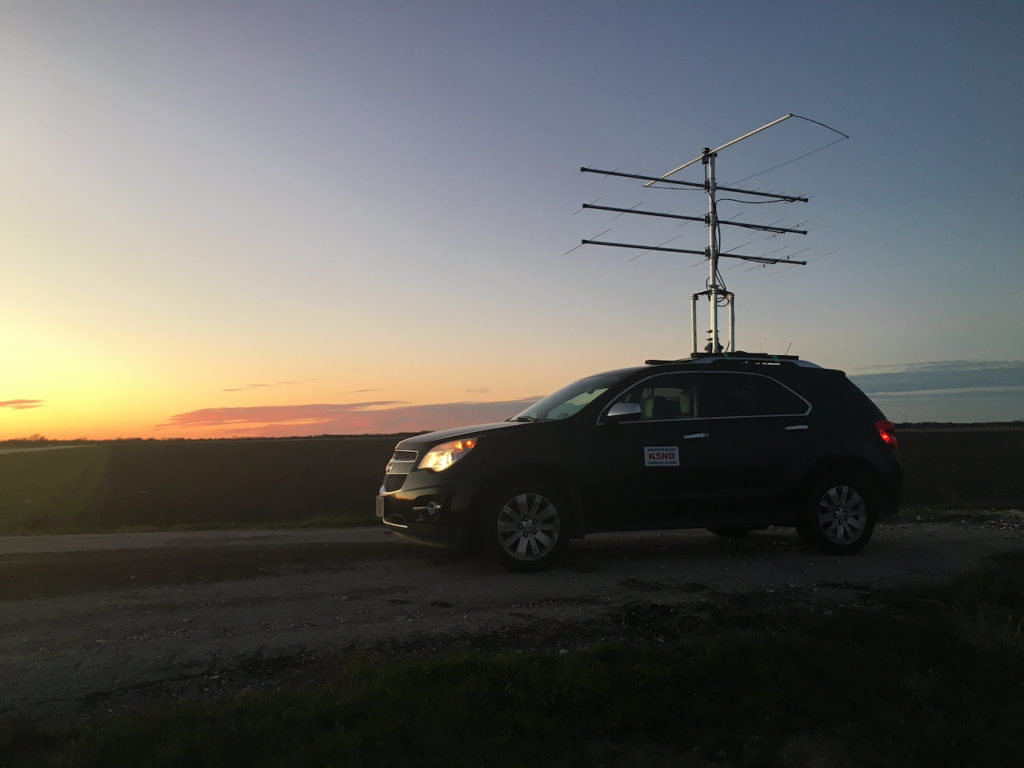

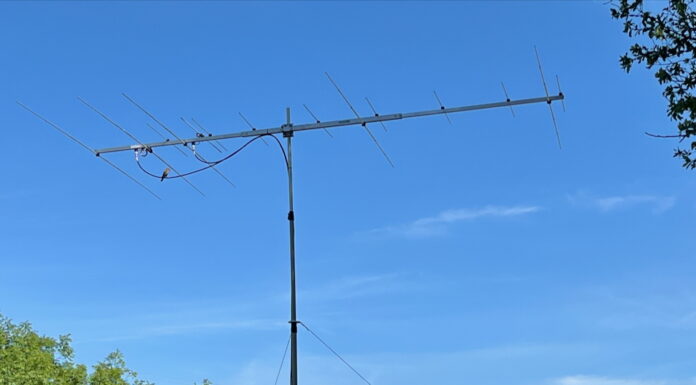







[…] the January 2020 VHF contest, I had Icom loaner IC-7300 and IC-9700 rigs with RFI issues — which I solved with lots of ferrite […]